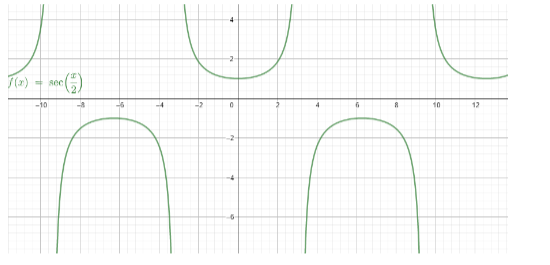
Answer
430.8k+ views
Hint:We explain the main function of the given equation $y=\sec \left( \dfrac{x}{2} \right)$. We take the general equation and explain the amplitude, period. Then we equate the given function $y=\sec\left( \dfrac{x}{2} \right)$ with the general one and find the graph.
Complete step by step solution:
We need to find the amplitude, period for $y=\sec \left( \dfrac{x}{2} \right)$.
The main function of the given equation is $\sec x$. The period of $\cos x$ is $2\pi $.
We define the general formula to explain the amplitude, period for $\sec x$.
The $\sec x$ changes to $A\sec \left[ B\left( x+C \right) \right]+D$, the amplitude and the period becomes $\left| A \right|$ and $\dfrac{2\pi }{\left| B \right|}$.
Now we explain the things for the given $y=\sec \left( \dfrac{x}{2} \right)$.
$y=\sec \left( \dfrac{x}{2} \right)=1\times \sec \left[ \dfrac{1}{2}\times x \right]$. We equate with $A\sec \left[ B\left( x+C \right) \right]+D$.
The values will be \[\left| A \right|=1;\left| B \right|=\dfrac{1}{2}\]. The period is $\dfrac{2\pi}{\dfrac{1}{2}}=2\pi \times 2=4\pi $.
Therefore, the amplitude and period for $y=\sec \left( \dfrac{x}{2} \right)$ is $1,4\pi $ respectively.
The usual common graph which is easier to plot on the graph is $y=\sec x$.
The graph is an oscillating graph with boundary being $\left( -\infty ,-1 \right)$ and $\left( 1,\infty\right)$.
The domain for the graph $y=\sec x$ is $\mathbb{R}$.
The range for the graph $y=\sec x$ is $\mathbb{R}\backslash \left( -1,1 \right)$.

Now depending on the above-mentioned graph, we are going to first find the graph of
$y=\sec \left( \dfrac{x}{2} \right)$.
The change between $y=\sec x$ and $y=\sec \left( \dfrac{x}{2} \right)$ is that the graph is now stretched for twice its previous area.
The domain for the graph $y=\sec \left( \dfrac{x}{2} \right)$ is $\mathbb{R}$.
The range for the graph $y=\sec \left( \dfrac{x}{2} \right)$ is $\mathbb{R}\backslash \left( -1,1 \right)$.

Note: Amplitude is the vertical distance from the X-axis to the highest (or lowest) point on a sin or cosine curve. Period of each generalized sine or cosine curve is the length of one complete cycle. The previous graphs were oscillating for an area of $\pi $ and now it’s for $2\pi $.
Complete step by step solution:
We need to find the amplitude, period for $y=\sec \left( \dfrac{x}{2} \right)$.
The main function of the given equation is $\sec x$. The period of $\cos x$ is $2\pi $.
We define the general formula to explain the amplitude, period for $\sec x$.
The $\sec x$ changes to $A\sec \left[ B\left( x+C \right) \right]+D$, the amplitude and the period becomes $\left| A \right|$ and $\dfrac{2\pi }{\left| B \right|}$.
Now we explain the things for the given $y=\sec \left( \dfrac{x}{2} \right)$.
$y=\sec \left( \dfrac{x}{2} \right)=1\times \sec \left[ \dfrac{1}{2}\times x \right]$. We equate with $A\sec \left[ B\left( x+C \right) \right]+D$.
The values will be \[\left| A \right|=1;\left| B \right|=\dfrac{1}{2}\]. The period is $\dfrac{2\pi}{\dfrac{1}{2}}=2\pi \times 2=4\pi $.
Therefore, the amplitude and period for $y=\sec \left( \dfrac{x}{2} \right)$ is $1,4\pi $ respectively.
The usual common graph which is easier to plot on the graph is $y=\sec x$.
The graph is an oscillating graph with boundary being $\left( -\infty ,-1 \right)$ and $\left( 1,\infty\right)$.
The domain for the graph $y=\sec x$ is $\mathbb{R}$.
The range for the graph $y=\sec x$ is $\mathbb{R}\backslash \left( -1,1 \right)$.

Now depending on the above-mentioned graph, we are going to first find the graph of
$y=\sec \left( \dfrac{x}{2} \right)$.
The change between $y=\sec x$ and $y=\sec \left( \dfrac{x}{2} \right)$ is that the graph is now stretched for twice its previous area.
The domain for the graph $y=\sec \left( \dfrac{x}{2} \right)$ is $\mathbb{R}$.
The range for the graph $y=\sec \left( \dfrac{x}{2} \right)$ is $\mathbb{R}\backslash \left( -1,1 \right)$.

Note: Amplitude is the vertical distance from the X-axis to the highest (or lowest) point on a sin or cosine curve. Period of each generalized sine or cosine curve is the length of one complete cycle. The previous graphs were oscillating for an area of $\pi $ and now it’s for $2\pi $.
Recently Updated Pages
Fill in the blanks with suitable prepositions Break class 10 english CBSE

Fill in the blanks with suitable articles Tribune is class 10 english CBSE

Rearrange the following words and phrases to form a class 10 english CBSE

Select the opposite of the given word Permit aGive class 10 english CBSE

Fill in the blank with the most appropriate option class 10 english CBSE

Some places have oneline notices Which option is a class 10 english CBSE

Trending doubts
Fill the blanks with the suitable prepositions 1 The class 9 english CBSE

How do you graph the function fx 4x class 9 maths CBSE

Which are the Top 10 Largest Countries of the World?

What is the definite integral of zero a constant b class 12 maths CBSE

The Equation xxx + 2 is Satisfied when x is Equal to Class 10 Maths

Differentiate between homogeneous and heterogeneous class 12 chemistry CBSE

Define the term system surroundings open system closed class 11 chemistry CBSE

Full Form of IASDMIPSIFSIRSPOLICE class 7 social science CBSE

Change the following sentences into negative and interrogative class 10 english CBSE




